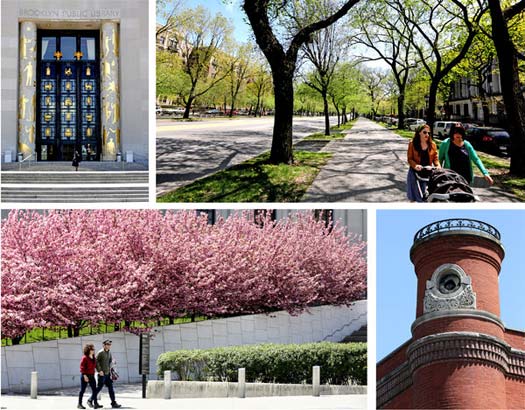
NYT: Brooklyn’s Champs-Élysées
Looking down Eastern Parkway from Grand Army Plaza’s Memorial Arch, past the Brooklyn Public Library, past the Botanic Garden and McKim, Mead and White’s Brooklyn Museum, you might be reminded of Paris and the broad avenues that radiate from the Arc de Triomphe. Mapped out in 1868 by Frederick Law Olmsted and Calvert Vaux, Eastern Parkway extends a little over two miles, from Prospect Park to Ralph Avenue.
HANDSOME APARTMENT BUILDINGS and houses line the shady boulevard, including a few — like Copley Plaza and Turner Towers — that would not look out of place on Park Avenue. Affluent Jewish professionals moved here in the early 20th century, and the parkway came to embody the city’s promise of social mobility and integration. Today, it is associated with a different strain of Jewish identity: the Chabad-Lubavitch movement has its world headquarters a few blocks away.
THE MASSIVE, CONCAVE FACADE of the Brooklyn Library’s Central Building resembles the open pages of a gilded book. The original plans, from 1907, were for a Beaux-Arts edifice with Greco-Roman details. But construction stalled for decades, and it was not until 1941 that the library was completed — along Modern Classical lines.
ACROSS EASTERN PARKWAY, Richard Meier and Partners’ polarizing condominium, completed in 2009, is the newest building in sight; next to the glass-walled block stands the Union Temple of Brooklyn, built in 1925 for a Reform community that migrated from Williamsburg to Flatbush. At first, the congregation asked Arnold Brunner, who designed the imposing neo-Classical home of Congregation Shearith Israel on Central Park West and 70th Street, to create a colonnaded temple where the Meier building now stands, but the crash of 1929 made that impractical; services have been held ever since in the 10-story community house. According to David Kaufman, the author of “Shul With a Pool” (1999), the athletic facilities here were typical of 1920s Jewish centers; today the Eastern Athletic Club leases them.
IMMEDIATELY TO THE NORTH of the parkway, the streets are largely residential, with shops and new restaurants and bars clustered on the avenues. Have a look at the Greenpoint Savings Bank (now a Capital One) on Washington Avenue near Lincoln Place; its facade looks like a huge fanlighted doorway flanked by Corinthian columns. At Grand Avenue and Park Place, a rose window, coffered wall panels and an indented, arched entry worthy of a Norman church seem like odd components for a police building, but the architect was George Ingram, who in the 1890s made a specialty of such elaborate precincts.














CH
No- there is nothing paris-like about Brooklyn, sorry.
Yossi Rubin
18 years ago this was reported in the L”Chaim Weekly 11 Nissan
All That’s Missing
“I was walking down Rue Champs de Elleyses in Paris doing mivtzoim,” says Yossi Rubin. “I passed a father and son strolling down the Avenue. I could tell that they were American tourists. I quickly walked over to them and asked, ‘Are you Jewish?’
“With a look of surprise, the father answered, ‘Yes and as a matter of fact, I was just pointing out to my son how Eastern Parkway in our hometown of Brooklyn is a copy of Champs Elleyses. The arch at Grand Army Plaza in Brooklyn is a replica of the Arch of Triumph here. But one thing was missing, I was telling my son. There were no Lubavitchers on Champs Elleyses like on Eastern Parkway. Suddenly you came and completed the picture!'”
declasse' intellectual
This article is a joke–get real!!!!!!!!
huh
An article like this without pictures is like… well… almost useless.
Very Paris like
High real estate prices and rents!